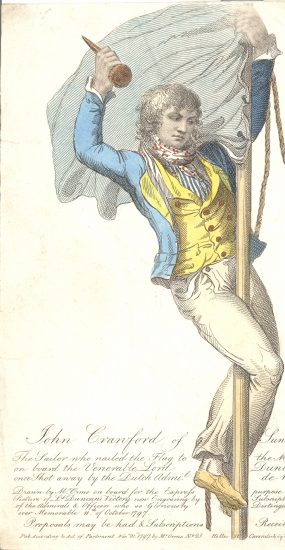
A nationwide appeal has been launched to find the flag that helped secure one of the Navy’s greatest victories.
The flag, or colours, were nailed to the mast of HMS Venerable by a young Sunderland sailor during the battle of Camperdown in 1797, a dangerous and pivotal action which changed the course of the fight.
And now, as Sunderland prepares to host The Tall Ships Races 2018, it has begun a campaign to bring the colours home to Wearside, in honour of Jack Crawford, the Hero of Camperdown.
The problem is they were last seen in 1890 and now no one knows where they are!
Councillor John Kelly, at Sunderland City Council, said: “Jack Crawford is very much a local hero so it would be fantastic to find the colours after all this time and bring them home to Sunderland for The Tall Ships races 2018.”
Born in Sunderland’s East End on 22 March 1775, Jack became a keelman aged just 11, ferrying coal on the River Wear.
Press ganged into the Royal Navy in 1796, he served on the gun ship HMS Venerable under Admiral Duncan, the Royal Navy Commander-in-Chief of the North Seas.
In 1797, Britain was at war with France, Holland and Spain and, on 11 October, the British and Dutch Navies met in battle off the coast of Norway, near Camperdown, close to Bergen.
Instead of forming a line of ships, Admiral Duncan split the British fleet into two groups, which broke through the Dutch ships, firing damaging broadsides.
It was a daring move, but successful, as it prevented the Dutch fleet from joining the French Navy and scuppered their plans to invade Ireland and then to attack Britain.
However, during the fierce fighting, HMS Venerable was badly damaged and the main mast, bearing its flag – or colours – was felled.
As the Union Flag (the original Union Jack without the red saltire of St Patrick) was the command flag of Admiral of the Fleet, its loss could have been interpreted as surrender.
But, under heavy fire, 22-year-old Jack climbed the mast and nailed the colours to the top, leading to victory for the British.
After the battle he was hailed a hero for his action and was honoured at a great victory procession in London.
In March 1798, the people of Sunderland presented him with a silver medal – now in Sunderland Museum – in honour of his daring act – and in January 1806, Jack was formally presented to King George III and granted a pension of £30 a year.
Jack died on 10 November 1831, aged just 56. He was the second victim of cholera in the town and was buried in the churchyard of Sunderland Parish Church, where a headstone, erected on the site in 1888, can still be seen today.
In 1890 a bronze statue commemorating his deed was erected in Sunderland’s Mowbray Park and unveiled by the Earl of Camperdown, the grandson of Admiral Duncan – and it is believed the colours Jack nailed to the mast were displayed at the ceremony.
“And, as far as we are aware, they have never been seen again,” said Michelle Daurat, project director for The Tall Ships Races Sunderland 2018, “and we believe the time has come to find them.”
As host port for the event, which will take place from 11-14 July 2018, Sunderland – once the UK’s largest shipbuilding port – expects to welcome up to 80 Tall Ships, “very similar indeed to the sort of ships on which Jack served during his time at sea,” said Michelle.
“He died in poverty and his heroic actions, which turned the tide of war, have largely been forgotten. But we want to change that and I can’t think of a better tribute to him or to the huge role played by this city to the nation’s maritime heritage, than to return the colours to Wearside.”
“If anyone, anywhere can help us track down the colours Jack nailed to the mast we desperately want to hear from them.”
Anyone who can shed light on the whereabouts of the colours should contact us here.
